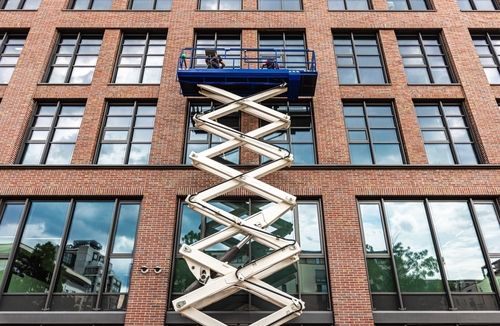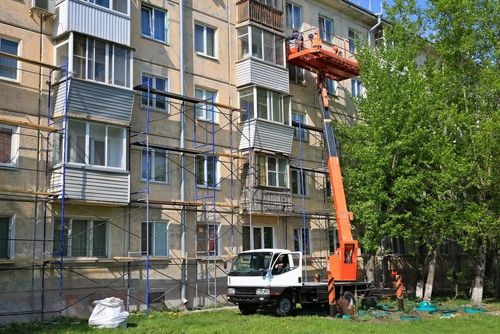Aerial Platform Safety Inspection Checklist
Aerial platform safety is a crucial component of guaranteeing a safe working environment for operators and people nearby. Scissor lifts, boom lifts, and cherry pickers are a few examples of aerial platforms that are extremely useful for operations that require working at a great height. Thoughtful detail-oriented attention and strict adherence to safety regulations are necessary for their safe operation.
In this blog, the team at Advanced CT will go in-depth on a checklist for an aerial platform safety inspection, stressing the essential elements and steps for a secure working environment.
Pre-Use Inspection

A pre-use examination is essential to find any obvious symptoms of damage, leaks, or problems before using an aerial platform. A visual inspection of the apparatus is part of this to make sure it is in good operating order. Look for any structural damage, oil or hydraulic leaks, or worn-out parts. Additionally, make sure that access gates, locks, and guardrails are firmly in place as well as that safety equipment such as emergency stop buttons is operational.
Operating and Safety Devices
Ensure that the joysticks and buttons on the aerial platform respond swiftly and precisely in every direction. Check the efficiency of safety equipment, such as limit switches, alarms, and emergency lowering systems. For reacting to crises and ensuring the platform operates safely, these safety equipment are crucial.
Hydraulic System
Check the hydraulic system for leaks, wear, or damage, paying particular attention to the hoses and fittings. The hydraulic system must operate correctly for the airborne platform to move and stay stable. Follow the manufacturer’s instructions when topping off low hydraulic fluid levels. Operating the platform safely and effectively depends on keeping the hydraulic system in good condition.
Electrical System
Examine the aerial platform’s electrical system in its entirety, paying special attention to the power wires, connections, plugs, lights, and indications. Keep an eye out for any obvious wear, fraying, or damage to the electrical components. Make sure that the battery is completely charged and operating properly since power-related issues might jeopardize the platform’s ability to operate safely.
Structural Integrity
Examine the aerial platform’s general structure for any indications of deterioration, malformations, or corrosion. For the platform to be stable and secure while operating, structural integrity is essential. Check welds, pins, fasteners, and other structural elements carefully to make sure they are tight, secure, and defect-free.
Ground Stability
Check the stability and compatibility of the ground surface where the aerial platform will be positioned. It’s crucial to check that the ground can support the platform’s weight and movement. Securely deploy outriggers or stabilizers to offer stability and avoid tipping. Safe aerial work requires a flat, solid platform.
Fall Protection and Guardrails
Verify that the aerial platform has suitable fall protection features, such as guardrails, to prevent platform falls. Check to make sure the guardrails are firmly in place and at the right height. Ensure suitable anchor points for attachment and emphasize the need to employ personal fall protection equipment, such as harnesses. The safety of an airborne platform depends on fall prevention.
Personal Protective Equipment (PPE)
Stress the value of personnel wearing personal protective equipment (PPE). Check to see that they are wearing the required safety equipment, such as harnesses, hard helmets, gloves, and the proper footwear. PPE is a crucial safety precaution to take to guard against risks and accidents when using the aerial platform.
Placement and Load Capacity
Inform operators of the need to adhere to the aerial platform’s maximum load capacity. To preserve stability, emphasize the need to disperse the weight uniformly throughout the platform. For safe operation and to avoid tipping or structural damage, proper load placement and adherence to load capacity requirements are essential.
Communication
Establish explicit communication rules between the platform operator and those on the ground. To plan moves, manoeuvres, and any potential crises, it is important to emphasize the need for excellent communication. Encourage operators to communicate effectively and safely using radios or hand signals.
Environmental and Weather Conditions

Insist on the necessity of evaluating the weather and surroundings before using the airborne platform. Operators should use caution in the presence of inclement weather, such as strong winds, storms, rain, or lightning. To guarantee their safety and the safety of others, tell operators to avoid utilizing the platform when it’s bad outside.
Emergency Actions
Go through and reiterate emergency protocols with operators, paying special attention to safely escaping the platform in an emergency. Make sure that the position of fire extinguishers, emergency stops, and emergency descent mechanisms is known to the operators. To improve readiness and reactivity in urgent situations, encourage emergency procedure practice.
Operator Education and Certification
Stress the significance of appropriate instruction and certification for aerial platform operators. Operators must have received thorough instruction on how to utilize the particular kind of aerial platform being used, including knowledge of its controls, safety features, emergency protocols, and best practices for safe operation. Operations that are safe and effective benefit greatly from having qualified operators.
Documentation
Stress the importance of keeping and having access to all necessary paperwork. Manuals, how-to instructions, and maintenance logs are examples of this. Make sure that the operators are aware of where to find these materials and how to use them for information, direction, and troubleshooting. Updated documentation that is easy to find promotes safe operations and informed decision-making.
Advanced CT – Leaders in Occupational Health & Safety
To safeguard the lives and welfare of employees, it is ethically responsible to place a high priority on aerial platform safety. Operators, supervisors, and safety officials can use the comprehensive safety inspection checklist provided in this book as a helpful tool to create a secure working environment. By incorporating these safety precautions into every facet of aerial platform operations, let’s secure a safer tomorrow. Keep yourself safe, and make workplace aerial platform safety a top priority.
Are you dedicated to enhancing workplace safety with accuracy and knowledge? Please contact us at Advanced CT and take your team’s safety to new heights. Our comprehensive aerial platform safety courses and other specialist health and safety training courses equip your personnel with the know-how and abilities they need to perform confidently. Safety is a shared responsibility, and at Advanced CT, we’re committed to assisting you at every turn. Starting today, let’s prioritize safety at your place of employment.

